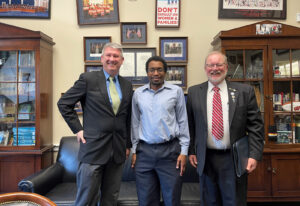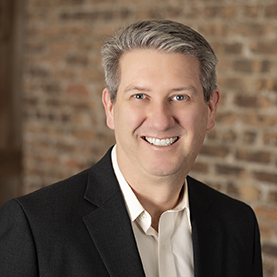
Left to right: Chris Tippery, Chris Goldson of Representative Gwen Moore’s office, Brandon Koltz
The following report provides a summary of information gathered during Water Week 2024.
Brandon Koltz, adjunct professor at Carthage College and owner of his own LLC firm, and I attended Water Week 2024 in Washington, DC, from April 8-10 on behalf of the following organizations: Central States Water Environment Association – Wisconsin Section, the Wisconsin Wastewater Operator’s Association, the League of Wisconsin Municipalities, the Municipal Environmental Group (MEG) – Wastewater Division, the Wisconsin Chapter of the American Water Works Association, the Wisconsin Chapter of the American Public Works Association, and the Wisconsin Rural Water Association. Water Week provides an opportunity for professionals to engage with our congressional elected and regulatory officials, discussing Wisconsin’s needs and concerns. In preparation for Water Week, I reached out to all represented organizations and inquired of their discussion points with our congressional representatives. Wisconsin’s needs are well aligned with those of the Water Environment Federation (WEF) and consist of funding, PFOA / PFAS, workforce development, and chlorides.
While in DC, Michael Mucha of the Madison Metropolitan Sewerage District, Brandon Koltz, and I met with staff from the offices of Senator Ron Johnson, Senator Tammy Baldwin, Representative Gwen Moore (District 4), and Representative Scott Fitzgerald (District 5) to discuss national and Wisconsin-specific issues. This discussion highlighted the topics of additional funding, PFOS / PFAS, especially within biosolids and their disposal, workforce development, and chlorides.
Regarding the current and future alignment of Congress in the fluctuating yet equivalent political environment, the current slim majority for either political party within each chamber (Senate or House) will likely continue. For Wisconsin, the Supreme Court’s newly redrawn Senate and Assembly maps may provide more equity within the State Legislature, but with the initial election occurring in November, the effect of these new maps remains to be seen.
We attended the Stormwater Policy Forum discussion focused on the Water Resources Development Act (WRDA) legislation funding, which is expected to pass Congress this summer, and emerging regulatory issues. The Environmental Protection Agency (EPA) is expected to address PFAS for aquatic life after promulgating the drinking water standards released in April 2024. Funding has been provided for the EPA to create Stormwater Centers of Excellence, which will address environmental and regulatory concerns, technical assistance for communities, and funding equity. In addition, the EPA is considering water quality criteria for 6PPDQ-quinone, which is found in vehicle tires and has been discovered to be toxic to some species of fish, notably salmon.
In addition, there is a growing push for the Energy-Water Nexus, which is a term applied to the relationship between the water and energy industries. Water and wastewater utilities are encouraged to develop more energy-efficient policies and practices, potentially in response to climate change concerns, but also to develop a collaborative approach with energy utilities to provide strategic services to communities, meaning to locally align demand with availability and plan regionally.
Funding
The Bipartisan Infrastructure Law (BIL), or the Infrastructure Investment and Jobs Act (IIJA) of 2021, has greatly increased funding for water and wastewater projects nationwide with $55 billion allocated, $13 billion spent to date, and $8.5 billion appropriated in 2024 with $4.4 billion dedicated to combined sewer overflows (CSO). The Water Infrastructure Financing and Innovation Act (WIFIA) funding also provides $19 billion for the water and wastewater industry.
In Wisconsin, the BIL funding is managed through the Wisconsin Department of Natural Resources (WDNR) through the State Revolving Fund (SRF) known as the Safe Drinking Water Loan (SDWL) and Clean Water Fund Loan (CWFL) programs. Per the WDNR, there has been an increased demand for funding in Wisconsin, potentially for principal forgiveness (PF), but also due to aging infrastructure and ongoing operational, maintenance, and enforcement needs. The 2024 Wisconsin BIL funding has already been allocated, and the demand is expected to continue to exceed available funding through the duration of the BIL funding period, 2027. For that reason, we continue to advocate for more funding for the SRF programs.
Earmarks, or congressionally directed spending, directly appropriate federal funds to approved projects. This benefits the local community, but also reduces the annual federal capitalization of the SRF program. Congressionally directed spending is not being appropriated in addition to SRF funding; it actually erodes it. More private investment is needed in water and wastewater as approximately 26% of all funding comes from the federal government.
The Chevron Doctrine, based on the 1984 U.S. Supreme Court case, Chevron v. Natural Resources Defense Council, provided governmental agencies the leeway for interpretation of federal laws. The Supreme Court is now considering overturning the Chevron Doctrine. The concern is that each new federal administration may be able to interpret federal laws differently, which may usher in system shocks and implement massive environmental law change every four or eight years. The court’s ruling could have ripple effects across the federal government, where agencies frequently use experts to interpret and implement federal laws.
PFOS / PFAS
This contaminant may be the initial, of potentially many, harmful chemicals and pollutants for human consumption and the environment. The EPA standards for PFOA / PFAS in drinking water of 4.0 parts per trillion (PPT), or nanograms per liter (ng/L), were recently released. This supersedes the previous rule, passed by the Wisconsin DNR, of 70 PPT (or 70 ng/L). The EPA will be addressing national discharge limits, monitoring public health and the environment, and addressing PFOS / PFAS in biosolids.
It is estimated that 20% of our PFOS / PFAS exposure is through water, and the remaining 80% is through other sources in our environment. The EPA will be conducting more research and development, as well as a risk assessment regarding the acceptable levels of PFOA / PFOS exposure in the environment.
For Wisconsin surface waters, PFOS was established at 8 ng/L in all waters without mixing zone dilution considerations. The Wisconsin surface water PFOA standard, which is based on drinking water protection, was tiered as follows: 20 ng/L (20 PPT) in waters that are public drinking water sources and 95 ng/L (95 PPT) in all other waters to ensure protection against the incidental ingestion of water by children during recreation.
The Wisconsin DNR was in the process of establishing groundwater standards, but the treatment costs exceeded the legislature-approved, allowable costs of $10 million over a two-year period. Therefore, the WDNR groundwater rule-making efforts were paused until the legislature approves the cost or process. Likely, the groundwater process may have to follow the EPA drinking water rule, but this has yet to be determined.
PFOA / PFOS in biosolids was also a prevalent topic. In August 2022, the EPA designated PFOA and PFOS as “hazardous substances” under the Comprehensive Environmental Response, Compensation & Liability Act (CERCLA, also known as the Superfund Law). Water, wastewater, and stormwater utilities are requesting that Congress provide a waiver for the transmission and presence of PFOA / PFOS within their flows, as these utilities merely convey or receive these products. Private companies created these products, and they should be the ones held responsible for their treatment and removal from the environment. Notably, PFOA and PFOS reside within wastewater biosolids, and there are concerns regarding the acceptance of biosolids for land application.
Expanding upon this point, companies who create chemicals for public use should evaluate the lifecycle of their product, from its creation and manufacturing to its disposal and return to the environment. They should be responsible for all costs from the use of their product, and if these costs exceed their desired profit margins, then they should not bring the product to market. In this way, manufacturing will be held accountable, and we will hopefully prevent the next environmental concern.
Workforce Development
Nationwide, the concerns are regarding attracting more and diverse talent into our industry. The current push is for educated staff with a higher degree of flexibility and adaptability being able to perform more tasks with fewer staff, which will be a requirement for our industry’s future.
Chlorides
Especially in Wisconsin where winter snow and ice are prevalent for months, chlorides can end up in the waterways through stormwater or water softener discharges. Excessive chloride discharges can increase the salinity of our freshwater, which is harmful to the environment and animals. The EPA has developed acute and chronic water quality criteria, to be implemented into practice by each state as mandated by federal law. In many cases, states seek criteria variance requirements and develop their own site-specific criteria for less stringent standards, requiring EPA concurrence. Each state may establish water quality criteria more stringent than the EPA criteria, but routinely request less stringent standards due to the cost or complexity of compliance for a particular pollutant.
Congressional Visits
Informational material was available from WEF, National Association of Clean Water Agencies (NACWA), and other water organizations regarding funding, emerging contaminants, and other issues. A stormwater informational brochure was prepared by WEF and the National Municipal Stormwater Association.
The DC Fly-In event provides an annual opportunity for Wisconsin’s water and wastewater industry experts to advocate for our needs and express our concerns to our elected officials. If you are interested in attending next year’s Fly-In event on behalf of Wisconsin, please contact Chris Tippery at either Chris.Tippery@raSmith.com or (414) 267-7335. Brandon and Chris would like to thank the Central States Water Environment Association-Wisconsin Section for their continued support by allowing us to attend the annual Fly-In. In addition, we would like to acknowledge WWOA’s financial contributions towards the 2024 Fly-In.
